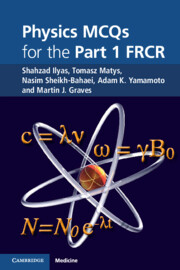Book contents
- Frontmatter
- Contents
- Preface
- Acknowledgements
- 1 Basic physics
- 2 Radiation hazards and protection
- 3 Imaging with X-rays
- 4 Film-screen radiography
- 5 Digital radiography
- 6 Fluoroscopy and mammography
- 7 Nuclear medicine
- 8 Computed tomography
- 9 Imaging with ultrasound
- 10 Magnetic resonance imaging
- Bibliography
- Index
6 - Fluoroscopy and mammography
Published online by Cambridge University Press: 05 July 2011
- Frontmatter
- Contents
- Preface
- Acknowledgements
- 1 Basic physics
- 2 Radiation hazards and protection
- 3 Imaging with X-rays
- 4 Film-screen radiography
- 5 Digital radiography
- 6 Fluoroscopy and mammography
- 7 Nuclear medicine
- 8 Computed tomography
- 9 Imaging with ultrasound
- 10 Magnetic resonance imaging
- Bibliography
- Index
Summary
Regarding the intensifier in fluoroscopy:
The chamber could be made of metal, e.g. aluminium, or of glass or ceramic
It is filled with ionized gas
There is a thin lead foil shielding the inner side of the chamber to prevent light from reaching the tube
The anode is made of aluminium
In fluoroscopy, γ is higher than in film-screen radiography
Regarding the input screen in fluoroscopy:
Each absorbed X-ray photon gives rise to nearly 3000 light photons in the blue part of the spectrum
The input phosphor is antimony caesium (SbCs3)
The input window is usually made of aluminium or titanium
The phosphor thickness is 1–4 mm
Only 60% of the incoming X-rays will be detected by the input phosphor
Regarding the output screen in the fluoroscopy:
The output phosphor is silver-activated zinc cadmium sulphide (ZnCdS:Ag)
The output phosphor emits green light
The size of the output screen depends on the application
The output phosphor is thicker than the input phosphor
To reduce scatter in the output window, very thick glass can be used
Regarding image intensifiers in fluoroscopy:
The diameter of the input screen is usually twice the diameter of the output screen
The intensity of light produced in the input phosphor and the number of electrons produced by the photocathode are directly proportional to the intensity of the X-ray
[…]
- Type
- Chapter
- Information
- Physics MCQs for the Part 1 FRCR , pp. 70 - 84Publisher: Cambridge University PressPrint publication year: 2011



